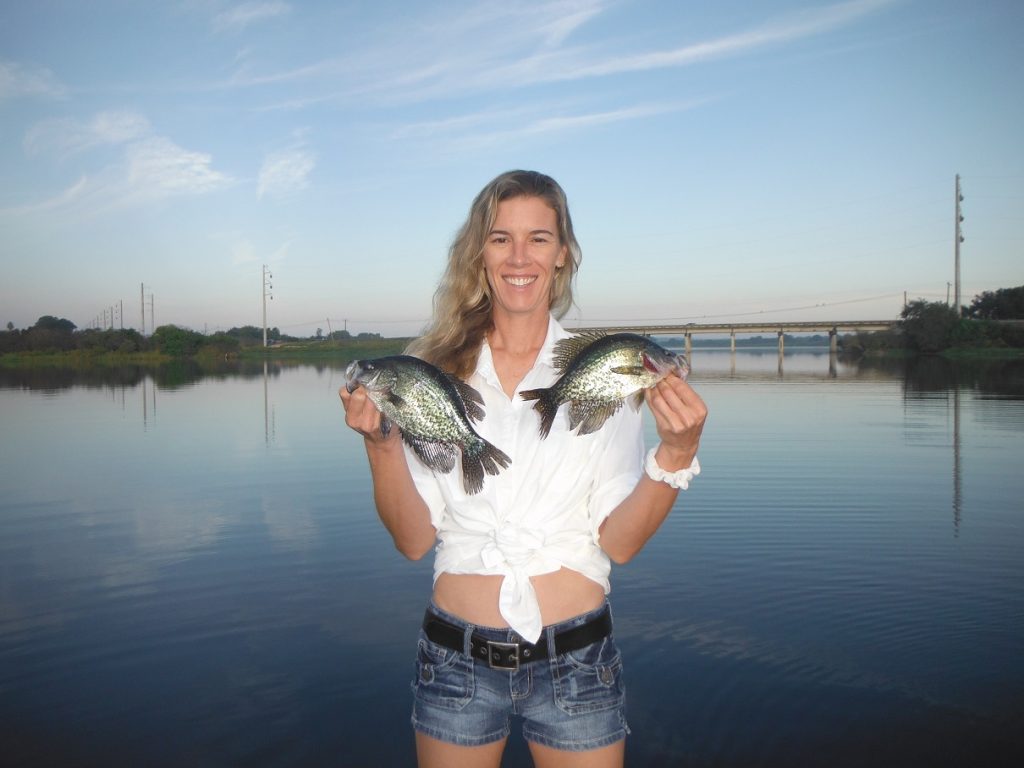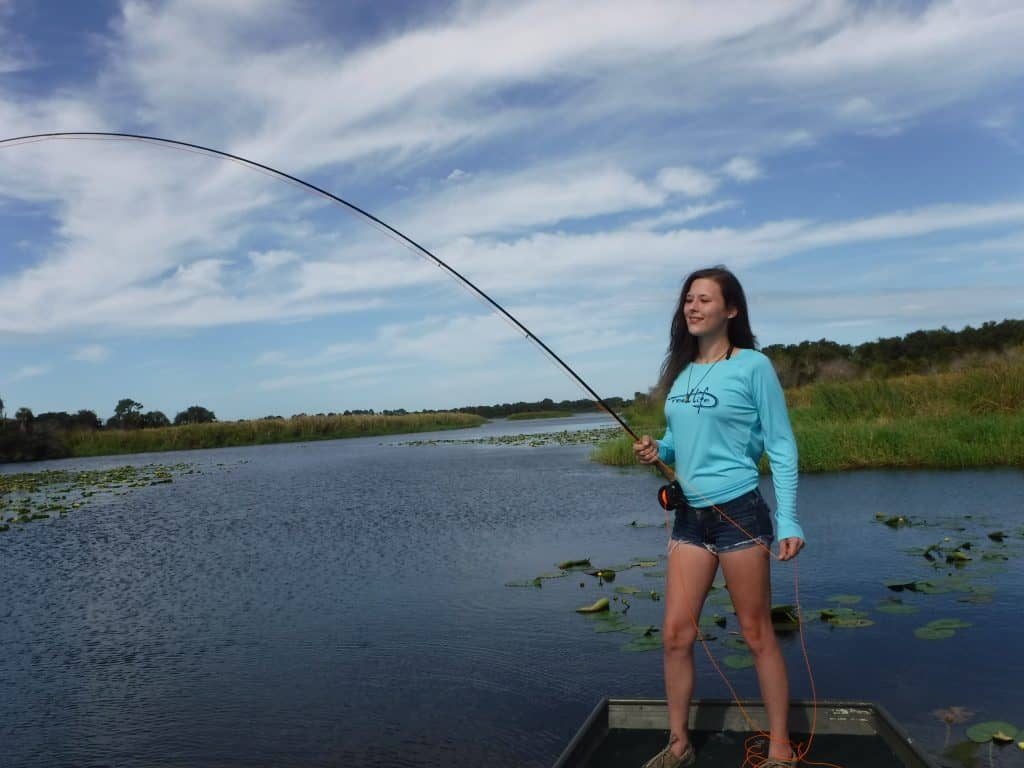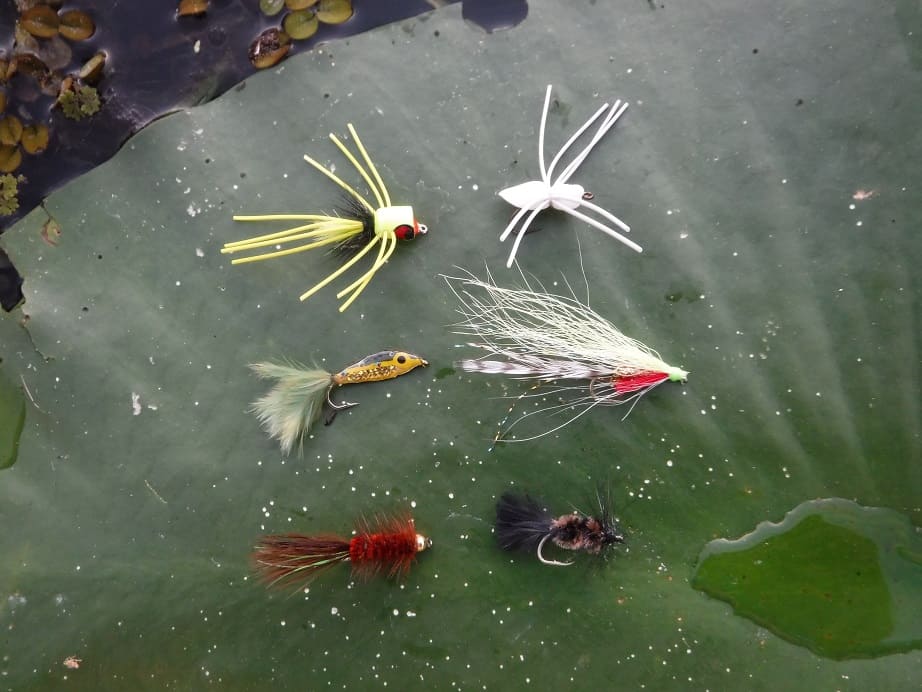
Fly Fishing for Crappie in Florida
The topic of this article will be fly fishing for crappie in Florida. Crappie are an extremely popular freshwater species. They are the largest member of the panfish family. In Florida, they are often referred to as “speckled perch”, or “specks” for short. Very few anglers target them with a fly rod, and I hope this article will help more anglers give it a try.
Read more about Florida freshwater fly fishing charters
Crappie almost always are found in larger schools in deeper water. This makes fly fishing for them quite difficult. Sinking lines and weighted flies would be required. However, just before, during, and after the spawn, crappie move in close to shore in shallow water. In this situation, they will readily take a well presented fly.
Fly fishing for crappie in Florida
My name is Capt. Jim Klopfer and I was a saltwater fishing guide in Florida for over 30 years. I recently moved to the Inverness, Florida area to pursue more freshwater fishing opportunities. While saltwater fishing can be exciting, I really enjoy the solitude, great scenery, an excellent fishing that this area offers. I like to chase all freshwater fish with a fly rod, including crappie.

The tackle used when fly fishing for crappie in Florida is pretty basic. I use a 4wt outfit with a floating line for the vast majority of my shallow water fly fishing for crappie and other panfish. A 9 foot leader that tapers down to 6 pound test or so works well. Most of the flies that I use when fly fishing for crappie in Florida either sink slowly or are weighted. Crappie are not well-known to take a popper or surface fly.
Crappie have a couple of habits that make them a prime target for anglers casting a fly. First is the fact that crappie feet almost exclusively on small bait fish. There are countless minnow imitations that anglers can tie on that will catch crappie. The other behavioral factor is the fact that crappie almost always feet above them, attacking prey from below. This means that anglers can fish a sinking fly with a floating line successfully.
Best crappie fishing flies
I use two different flies almost exclusively for the vast majority of my crappie fishing trips. These are a white and chartreuse Closer minnow pattern and a locally regional pattern from Sarasota called a Myakka Minnow. It is simply a variation of other glass minnow type patterns.

In all reality, the Clouser minnow fly is just a buck tail jig. It consists of a hook, weighted eyes, and some type of dressing. I prefer buck tail. And as all experience crappie anglers know, a small jig is a deadly crappie fishing lure. It also rides with the hook facing up, reducing hangups and snags.
The Myakka minnow fly does not look like much. It consists of a hook with a chartreuse tail, usually made from marabou. The body is then built up with Fred to be rounder in the middle and tapered at the ends. It is then covered with gold mylar. Anglers can add eyes if desired, but I really have not found them to be necessary. I will also wrap the shank of the hook with wire if I wanted to be a tad heavier.
One other pattern that is very productive is the woolly bugger. I use is quite often when targeting bass and other panfish, especially bluegill. While it is not my first choice if I’m specifically after crappie, it is a very effective and versatile all round fly.
Fly fishing techniques for Florida crappie
The techniques that I use when fly fishing for crappie in Florida are pretty straightforward. Like most fish, crappie are usually found around some type of structure. Crappie love would, so any fallen tree or dock is a prime target. In the area of Florida that I fish, vegetation is key as well. Weed edges, submerged hydrilla and other vegetation, and areas where vegetation meets would are all prime spots.
The fly is cast out, allowed to settle a few seconds, then retrieved back in using a sharp, short strip followed by a pause. Many times the strike occurs during this pause when the fly just covers their seemingly helpless. This jerk and pause action simulates a wounded bait fish and will definitely trigger a strike.
Crappie are a schooling fish, which is both good news and bad. The good news is that once located, a bunch of fish can be caught in short order. The bad news is that anglers will sometimes have to move around quite a bit in order to find them.
Once again, the prime times for anglers fly fishing for crappie in Florida are the cooler months. The timing will change about a month or so depending on what part of Florida the angler is fishing in. Somewhere between Halloween and Thanksgiving, crappie will school up in large numbers and slightly deeper water. Channel edges and deeper holes are prime spots.
Best times to fly fish for Florida crappie
As it cools off and after the full moon, these larger schools will often break up and fish will move to the bank. This is the time to catch them on a fly rod! Unlike some other freshwater species, crappie will pretty much feed steadily through the next few months. Again, the key is just to keep moving until a school of fish is located.
While there are a variety of reasons that anglers pursue crappie, there is no doubt that there snow white fillets are a huge reason. I am going to mention conservation just a moment here. While the crappie regulations in Florida are fairly generous, right now it is 25 fish per angler, they can be over-fished. This is happening in some of the famous crappie fisheries in Florida right now. Keep a few fish for dinner by all means, but please don’t be greedy and try to fill the freezer to take home back north.
In conclusion, this article on fly fishing for crappie in Florida will hopefully give more anglers the confidence and interest to catch these beautiful and tasty panfish on the long rod!